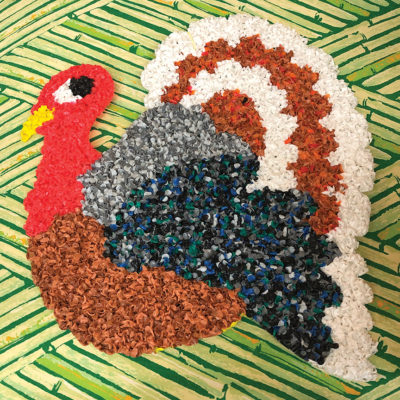Dorri Partain
Northeast News
Whether hung on a door, a wall, or in a window, these bright-colored decorations were a holiday staple for several decades.
Proudly made in the U.S.A. by the Kage Company of Manchester, Conneticutt, they had a bumpy texture that earned them the nickname “popcorn decorations.”
The manufacturer, however, marketed their variety of styles as “Glitter Plaques.” Despite never containing any glitter in their composition, the plastic chips were shiny and caught light, giving the surface a glittering effect.
The plastic “chips” were actually polyethylene pellets used to make envelopes and bank passbooks, which composed Kage Company’s main line of products.
Company owner Kibbe Gerstein had taken home a box of colorful pellet samples, which his young daughter Elaine put to an alternate use.
Home from school one day due to illness, she had taken the pellets and crafted a picture of a chicken.
When Gerstein come home from work, they transferred the design to a baking sheet and popped it into the oven.
After baking 10 minutes, the pellets had melted enough to join together while creating a bumpy texture.
On a whim, he took his daughter’s design with him to a trade show and ended up with an order for 25,000 plaques from the W.T. Grant Co., a popular department store at that time.
Gerstein created molds for additional designs, which helped hold the shape during baking and showed placement for the different colored sections.
Glitter Plaques were produced for all the major holidays: Halloween, Christmas, Easter, Valentine’s Day, St. Patrick’s Day.
Thanksgiving designs included a turkey, boy and girl pilgrims, and boy and girl Native Americans.
Along with multiple styles of santas and rudolphs, Kage also offered designs of popular cartoon characters, including Snoopy, Smokey The Bear, Betty Boop, and Warner Brothers Looney Tunes.
Approximately 200 different styles of Glitter Plaques were offered from the late 1960s through 2008, when the manufacturer ceased production.



















